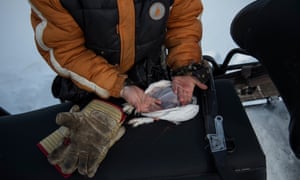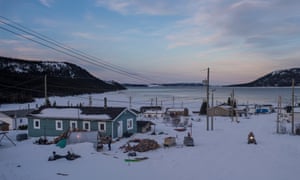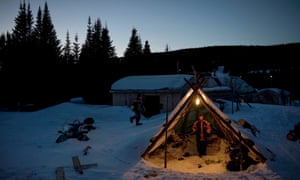Extract from The Guardian
Every aspect of the indigenous Inuit culture grows from the land –
but the unpredictable seasons are forcing the community to adjust their
traditions
Martin Shiwak is navigating his snowmobile along the frozen shoreline
when his eight-year-old son Dane, who is riding on the back, points at a
wall of stunted spruce trees.
Shiwak cuts the engine, hops off the machine and quietly pulls out a .12 gauge shotgun. He hands the weapon to Dane, and the pair crouch behind their snowmobile. Dane fires two quick shots. Two white partridges, almost invisible in the tree line, drop dead.
Dane runs to retrieve the birds, warming his hands against their bodies to ward off the chill from the cold wind whipping in from the North Atlantic Ocean.
Shiwak is an Inuit trapper and hunter who grew up relying on the wild bounty of Labrador. He takes his son out for trips like this every week, trying to pass on generations of knowledge around living off the land: how to collect firewood, hunt and fish, and travel safely in a place where the rhythm of life is still built upon ice and snow.
But he’s running out of time.
The sea surrounding coastal Labrador is warming at an unprecedented rate, according to data from Canada’s Department of Fisheries and Oceans.
Robert Way, a climatologist based in Happy Valley-Goose Bay, said the region is a volatile place climatically, with extreme swings in the weather that can amplify – and sometimes mask – the changes that are happening. Compared to historical terms, winter is about six weeks shorter, while the region’s sea ice coverage is about third smaller than it was a decade ago.

Shiwak cuts the engine, hops off the machine and quietly pulls out a .12 gauge shotgun. He hands the weapon to Dane, and the pair crouch behind their snowmobile. Dane fires two quick shots. Two white partridges, almost invisible in the tree line, drop dead.
Dane runs to retrieve the birds, warming his hands against their bodies to ward off the chill from the cold wind whipping in from the North Atlantic Ocean.
Shiwak is an Inuit trapper and hunter who grew up relying on the wild bounty of Labrador. He takes his son out for trips like this every week, trying to pass on generations of knowledge around living off the land: how to collect firewood, hunt and fish, and travel safely in a place where the rhythm of life is still built upon ice and snow.
But he’s running out of time.
The sea surrounding coastal Labrador is warming at an unprecedented rate, according to data from Canada’s Department of Fisheries and Oceans.
Robert Way, a climatologist based in Happy Valley-Goose Bay, said the region is a volatile place climatically, with extreme swings in the weather that can amplify – and sometimes mask – the changes that are happening. Compared to historical terms, winter is about six weeks shorter, while the region’s sea ice coverage is about third smaller than it was a decade ago.

For the people of Rigolet, a former trading post that is the southernmost Inuit community in Canada, the vanishing ice and increasingly unpredictable seasons means they’re being forced to adapt in ways they never have before.
Like generations of Inuit before him, Derrick Pottle is a trapper and hunter. His diet of wild game, salmon, berries, trout and seal would have been familiar to his ancestors who were living in Hamilton Inlet around 8,000 years ago.
But Pottle worries all the skills he’s learned from older generations may soon become irrelevant. More and more, Inuit are relying on expensive, store-bought processed foods because it’s safer and easier than catching or shooting supper.
Pottle’s ancestors never experienced a time when their frozen world in northern Labrador was being altered so dramatically because of climate change. Shrinking ice packs and more severe weather has made travel increasingly difficult and dangerous, often cutting people off from other communities and traditional hunting lands.
There are no roads connecting Rigolet to other communities, so people here long ago came to rely on trails over the ice as their lifelines. But those frozen lifelines are increasingly unreliable, prone to sudden thaws, weak ice and dangerous openings.“I’m seeing changes that impact the way that we live,” Pottle said. “The sea, the ice, the snow, it’s all changing. You can’t travel safely any more. Up and down the coast, it’s the same thing. And it’s changing right before our eyes.”
“I was driving my truck last year and there was this big black cloud that suddenly appeared on the windshield. I had to use my wipers to clear it, I didn’t know what it was,” she said. “It was the flies. It used to be the end of June before you saw your first fly. Now they’re coming in May.”
Some of the changes are harder to see. McLean-Sheppard worries that as coastal Labrador’s sea ice becomes increasingly unreliable, it’s causing more anxiety among Inuit who feel stuck and unable to travel to catch their food. This past winter, the ice in the bay didn’t freeze up until February, months later than normal.
“It’s especially hard on the hunters and providers because they can’t get out on the land. They feel stuck,” she said. “We’re like an island, really. We need the ice to connect us.”
Living off the land is still a big part of life in Labrador’s coastal communities. Hunters provide meat to community freezers for sharing with seniors and others who can’t catch their own food. The freezers are filled with Labrador’s wild buffet, from partridge berries and Arctic char to moose, duck and goose meat. Each year the Rigolet community is allowed to kill two polar bears, and the meat is divided up for families up and down the rugged coastline.
Scientists say the impact of climate change on the Inuit psyche is significant, and only just beginning to be understood. Social workers worry it is leading to increased rates of drugs and alcohol abuse, in a place where the suicide rate far outstrips the national.
“The land is not just the land for them. It’s family, it’s kin, it’s part of you. Every aspect of Inuit culture grows from the land,” said Ashlee Cunsolo, director of the Labrador Institute in Happy Valley-Goose Bay.
“When you’re the first generation that can’t do that any more, that can’t follow your ancestors on to the land, think about how devastating that can be from a cultural standpoint. It’s a disruption to cultural traditions that have endured for hundreds of years.”
Cunsolo is one of leading researchers into the links between climate change and mental health. She says the rapid changes happening in coastal Labrador are causing the Inuit to feel increased feelings of anxiety, depression and grief. They sense something is being lost, she said.

Many of the Inuit in Rigolet are just a generation removed from the government relocation programs of the 1960s, when families were forced to abandon their nomadic ways and settle in larger communities. They say it’s in their blood to travel out into the wilderness. Inez Shiwak, who is working to preserve local Inuit culture in Rigolet, smiles when she says getting away from the village and into the wild is “like taking your first breath when you were a baby”.
Her father Jack Shiwak, the village’s mayor, said elders have noticed that the wind whipping in from the ocean is getting more severe. It can cause blinding snowstorms, and some people have been lost on snowmobile trails because of it. The unpredictable weather is causing some Inuit to reduce trips to their remote cabins, a tradition that dates backs to the days when fur trapping was a major industry in the region, he said.
“Until five years ago, we’d hardly miss a week of going to the cabin. We haven’t been there is two years. It’s just the weather,” Shiwak said. “It’s a strange feeling. We know things are changing, but you realize you can’t stop it. The question is how we adapt.”
Back out on the frozen shoreline a few miles outside of the village, Martin Shiwak stops his snowmobile again and looks out over the bay. The sun is shining now and the hunter unzips his coat, remarking this is one of the mildest Marches he’s ever seen.
He knows this wild land intimately. But lately he’s starting to recognize it less and less. This is the first winter Shiwak couldn’t cross nearby Lake Melville to go trapping because he couldn’t trust the ice. It’s also the first winter he’s had to cancel an educational program that used to bring youth out on the ice and show them the old practices of their people.
Shiwak worries what life will be like for Dane, as the traditions of the father grow harder and harder for the son to maintain. Labrador’s youngest Inuit will have to learn new ways to live with a land that is changing all the time, he said.
“It affects everything,” he said. “I just know it’ll be a lot different than it is now.”

No comments:
Post a Comment